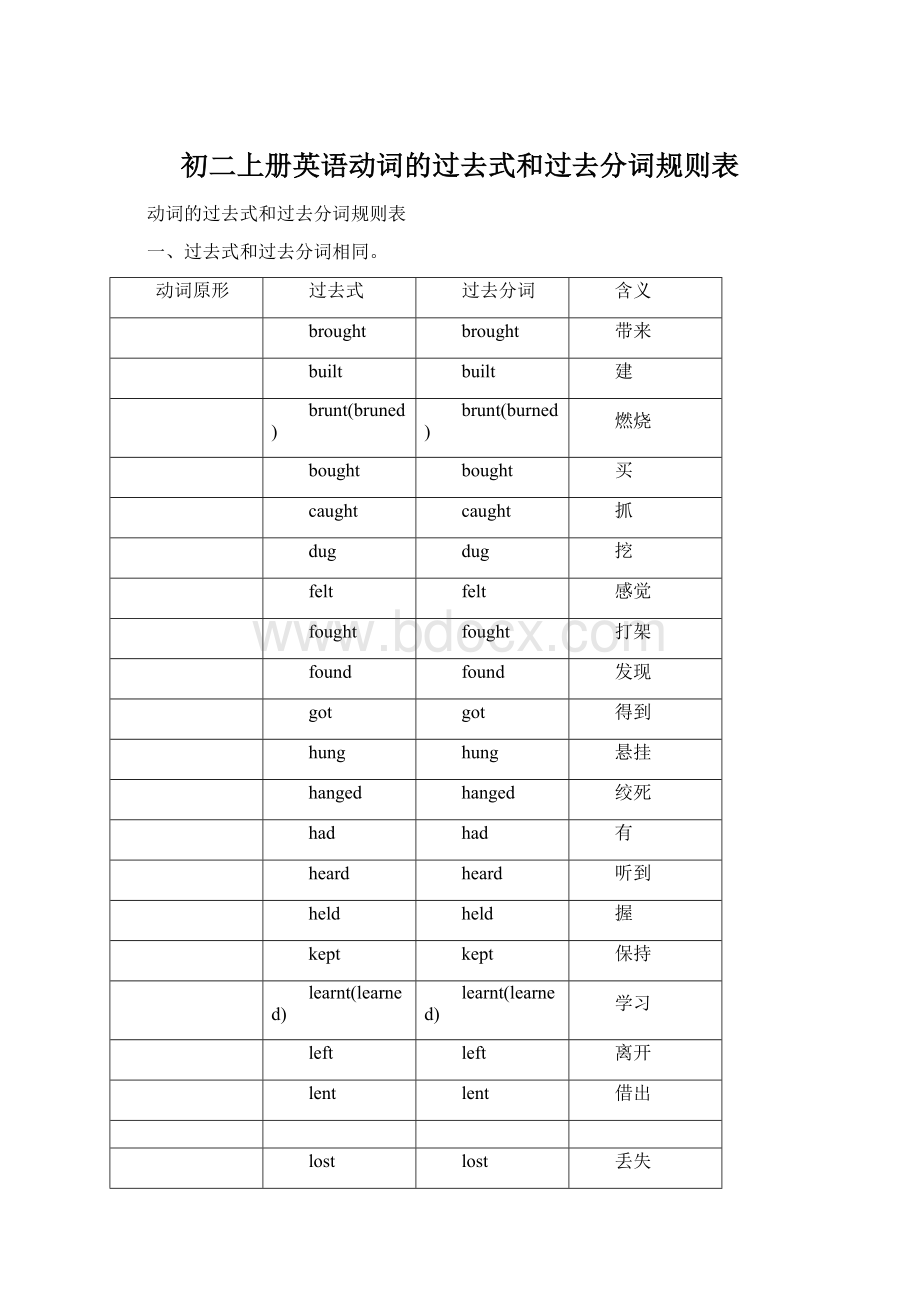初二上册英语动词的过去式和过去分词规则表.docx
《初二上册英语动词的过去式和过去分词规则表.docx》由会员分享,可在线阅读,更多相关《初二上册英语动词的过去式和过去分词规则表.docx(14页珍藏版)》请在冰豆网上搜索。

初二上册英语动词的过去式和过去分词规则表
动词的过去式和过去分词规则表
一、过去式和过去分词相同。
动词原形
过去式
过去分词
含义
brought
brought
带来
built
built
建
brunt(bruned)
brunt(burned)
燃烧
bought
bought
买
caught
caught
抓
dug
dug
挖
felt
felt
感觉
fought
fought
打架
found
found
发现
got
got
得到
hung
hung
悬挂
hanged
hanged
绞死
had
had
有
heard
heard
听到
held
held
握
kept
kept
保持
learnt(learned)
learnt(learned)
学习
left
left
离开
lent
lent
借出
lost
lost
丢失
made
made
制造
meant
meant
意思是
met
met
遇到
paid
paid
付款
said
said
说
sold
sold
卖
sent
sent
送
shone(shined)
shone(shined)
发光
sat
sat
坐
slept
slept
睡
smelt(smelled)
smelt(smelled)
嗅
spent
psent
花费
stood
stood
站
swept
swept
扫
taught
taught
教
told
told
告诉
thought
thought
想
understood
understood
理解
won
won
赢
二、动词的过去分词是在动词原形后加n或者en.
动词原形
过去式
过去分词
含义
beat
beaten
打
blew
blown
吹
drew
drawn
拉
drove
driven
驾驶
ate
eaten
吃
fell
fallen
下落
gave
given
给
grew
grown
生长
knew
known
知道
mistook
mistaken
弄错
rode
ridden
乘、骑
rose
risen
升
saw
seen
看见
showed
shown
出示,表现
took
taken
拿走
threw
thrown
抛、掷
wrote
written
写
三、原形、过去式和过去分词相同。
动词原形
过去式
过去分词
含义
cost
cost
值(多少)钱
cut
cut
切、割
hit
hit
打
hurt
hurt
伤害、伤痛
let
let
让
put
put
放
read
read
读
四、原形中的i,过去式改为a,过去分词改为u。
动词原形
过去式
过去分词
含义
began
begun
开始
drank
drunk
饮
rang
rung
响
sang
sung
唱
swam
swum
游泳
五、动词的过去分词是在过去式后加n或en.
动词原形
过去式
过去分词
含义
broke
broken
打碎
chose
chosen
选择
forgot
forgotten
忘记
spoke
spoken
讲
woke
woken
醒
六、动词原形、过去式和过去分词都各不相同。
动词原形
过去式
过去分词
含义
became
become
成为
came
come
来
ran
run
跑
七、动词原形、过去式和过去分词都各不相同。
动词原形
过去式
过去分词
含义
is
was
been
是
were
been
是
did
done
做
flew
flown
飞
went
gone
去
lay
lain
躺
wore
worn
穿
八、动词的过去分词是在动词原形后加n或者en.
动词原形
过去式
过去分词
含义
could
能
might
可以
must
必须
should
将要
would
愿、要、将、会
请把下列动词选填到各题空格处并改为适当的形式(可以重复选用)。
(be,break,come,do,drive,enjoy,fall,get,go,have,leave,lose,rain,run,seem,stay,stop,take,teach,tell,write)
1.Howmanypeople
(1)______thereatthepartylastSaturdayafternoon
2.He
(2)______hungrybecausehenot(3)hisbreakfastthismorning.
4.Theysaythetrain(13)______fasterandsaferthanthebusdoes,sowe(14)______thetraintoKaohsiungyesterday.
5.BecauseI(15)______illInot(16)toschoolthedaybefore.
6.Haveyoufoundthebicycleyou(17)______theotherday
7.There(18)______fewschoolsinthosedays.
8.Usuallymyfather(19)______towork,buthe(20)______thebusthismorning,forhiscar(21)______downonhiswayhomeyesterday.
1.一般过去时表示过去某个时间发生的动作或存在的状态,常和表示过去的时间状语连用。
一般过去时也表示过去经常或反复发生的动作感谢。
2.Be动词在一般过去时中的变化:
⑴am和is在一般过去时中变为was。
(wasnot=wasn’t)
⑵are在一般过去时中变为were。
(werenot=weren’t)
⑶带有was或were的句子,其否定、疑问的变化和is,am,are一样,即否定句在was或were后加not,一般疑问句把was或were调到句首。
3.句中没有be动词的一般过去时的句子
否定句:
didn’t+动词原形,如:
Jimdidn’tgohomeyesterday.
一般疑问句:
在句首加did,句子中的动词过去式变回原形。
如:
DidJimgohomeyesterday
特殊疑问句:
⑴疑问词+did+主语+动词原形
如:
WhatdidJimdoyesterday
⑵疑问词当主语时:
疑问词+动词过去式
如:
Whowenttohomeyesterday
①一般过去时,表示过去发生的动作或存在的状态。
②一般过去时的时态,标志为过去时间点。
常见的过去时时间有:
yesterday、lastnight(昨天晚上)1981等等。
③一般过去时中的谓语动词要用过去式。
④一般过去时态的句子没有第三人称的用法,不管主语是第几人称,动词都可用过去式。
⑤没有dodoes之分,全部用did
变否定句:
Iwenttothezooyesterday.
——Ididn’tgotothezooyesterday.
划线部分提问:
Iwenttothezooyesterday.
——Whendidyougotothezoo
一般过去时态表示过去某一时间或某一段时间内发生过的动作或存在的状态。
1.be动词的过去式:
am
was
be is
are were
否定式:
wasn’t,weren’t
一般疑问句:
将was和were提到句首。
2.规则动词的过去式的变化规则及读音:
(1)一般情况在动词原形后加-edwant
answerwanted
answered
(2)以字母e结尾的动词,只加-dmove
diemoved
died
(3)以“辅音字母+y”结尾的动词,把y改为i,再加-edcarry
crycarried
cried
(4)以重读闭音节结尾,末尾只有一个辅音字母,先双写该辅音字母,再加-ed。
如:
stop
stopped,plan,planned
加ed之后的读音规则:
1)清念/t/,即ed在清辅音后面念/t/
例如:
finished,helped,passed,cooked
2)元浊/d/,即ed在元音,浊辅音后面念/d/
例如:
enjoyed,called,moved,borrowed
3)/t/ /d/之后念/id/,即ed在/t//d/音后面念/id/
例如:
wanted,shouted,needed,counted
3.常用的一般过去时的时间状语:
yesterday/thedaybefore(在...之前)yesterday
lastyear/month/spring/week/Monday/night
yesterdaymorning/afternoon/evening
atthattime/justnow=amomentago
twodaysago/3yearsago/5monthsago/aweekago
in1990/2000/1988/1949
intheolddays/inthosedays
WhatdidyoudolastSunday
你上一个星期天做什么了
讲解:
(1)一般过去时
①一般过去时,表示过去发生的动作或存在的状态。
②一般过去时的时态,标志为过去时间点。
常见的过去时时间有:
yesterday、lastnight(昨天晚上)1981等等。
③一般过去时中的谓语动词要用过去式。
④一般过去时态的句子没有第三人称的用法,不管主语是第几人称,动词都可用过去式。
⑤没有dodoes之分,全部用did
变否定句:
Iwenttothezooyesterday.
——Ididn’tgotothezooyesterday.
划线部分提问:
Iwenttothezooyesterday.
——Whendidyougotothezoo
翻译:
昨天晚上我在家里
变否定句:
Hedoeshishomeworklastnight.
变成一般疑问句:
Iboughtsomefishyesterday.
划线部分提问:
Hedoeshishomeworklastnight.
翻译:
你昨天晚上在家里看电视了吗
是的,我在/不,我没有。
你昨天在家吗
是的,我在/不,我没有。
WhatdidyoudolastSunday
你上一个星期天做什么了
讲解:
(1)一般过去时
①一般过去时,表示过去发生的动作或存在的状态。
②一般过去时的时态,标志为过去时间点。
常见的过去时时间有:
yesterday、lastnight(昨天晚上)1981等等。
③一般过去时中的谓语动词要用过去式。
④一般过去时态的句子没有第三人称的用法,不管主语是第几人称,动词都可用过去式。
⑤没有dodoes之分,全部用did
变否定句:
Iwenttothezooyesterday.
——Ididn’tgotothezooyesterday.
划线部分提问:
Iwenttothezooyesterday.
——Whendidyougotothezoo
翻译:
昨天晚上我在家里
变否定句:
Hedoeshishomeworklastnight.
变成一般疑问句:
Iboughtsomefishyesterday.
划线部分提问:
Hedoeshishomeworklastnight.
翻译:
你昨天晚上在家里看电视了吗
是的,我在/不,我没有。
你昨天在家吗
是的,我在/不,我没有。
(2)last上一个的 next下一个的
lastweek上一周 上个月
nextweek下一周 下个月
(3)last还可以做最后讲:
最后atlast
终于intheend
翻译:
HeisthelastboyIwantgosee.
ThisisthelastthingIwanttodo.
Tomrunsfirst,Jimrunslast.
AtlastIpassedtheexam.
(4)last持续
如:
Therainlasted2days.
动词在形变为过去式的一般规则:
(1)一般词属加ed如:
work—worked
ed的读音规则:
①清清浊浊。
即:
清辅音后读清辅音[t]如looked[lukt]
浊辅音后读浊辅音[d]如climbed[klaimd]
②元音后读[d]。
如:
played[pleid]
①原来以t,d结尾的动词加上ed后读[id]。
]如:
wanted[
(2)动词以e结尾的直接加d。
如closed
](3)以一个元音字母加一个辅音字母结尾的,双写这个辅音字母再加ed。
如:
stop–stopped[
a.动词过去式的变化可速记为“直”、“去”、“双”、“改”四字诀。
①一般情况下在动词原形后直接加-ed.如:
wanted,played.
②以不发音的字母e结尾的动词,去掉e再加-ed.如:
hoped,lived.
③重读闭音节单词需双写最后一个辅音字母再加-ed.如:
stopped.
④以辅音字母+y结尾的动词变y为i,再加-ed.如:
studied,worried.
规则动词过去式的读音也有规律可循。
请记住:
清后[t],元浊[d],[t][d]之后读[Id].
①清辅音[p][k][f][s]等后,ed要读[t].如:
worked,finished.
②元音或浊辅音[b][g][v][z][m]等后,ed要读[d].如:
lived,called.
③[t]或[d]后,ed读[Id].如:
started,needed.
b.不规则动词变化,要逐一熟记。
be动词过去式有两种形式,主语是第一、三人称单数形式使用was,其他人称用were.
a.动词过去式的变化可速记为“直”、“去”、“双”、“改”四字诀。
①一般情况下在动词原形后直接加-ed.如:
wanted,played.
②以不发音的字母e结尾的动词,去掉e再加-ed.如:
hoped,lived.
③重读闭音节单词需双写最后一个辅音字母再加-ed.如:
stopped.
④以辅音字母+y结尾的动词变y为i,再加-ed.如:
studied,worried.
规则动词过去式的读音也有规律可循。
请记住:
清后[t],元浊[d],[t][d]之后读[Id].
①清辅音[p][k][f][s]等后,ed要读[t].如:
worked,finished.
②元音或浊辅音[b][g][v][z][m]等后,ed要读[d].如:
lived,called.
③[t]或[d]后,ed读[Id].如:
started,needed.
b.不规则动词变化,要逐一熟记。
be动词过去式有两种形式,主语是第一、三人称单数形式使用was,其他人称用were.
常用的一般过去时的时间状语:
yesterday/thedaybefore(在...之前)yesterday
lastyear/month/spring/week/Monday/night
yesterdaymorning/afternoon/evening
atthattime/justnow=amomentago
twodaysago/3yearsago/5monthsago/aweekago
in1990/2000/1988/1949
intheolddays/inthosedays
高分突破:
两类应注意的题:
1.交际英语中表示过去发生的动作:
“Pleaselookatthesign:
NOPHOTOS!
”
“Sorry,I______it.”
A.don’tsee B.see C.saw D.didn’tsee
正确答案:
D
2.客观真理用一般现在时:
Myteachertoldmethattheearth_____roundthesun.
A.moved B.moves C.move D.ran
a.be动词过去式的句式。
否定句是在was/were后面加not,wasnot(wasn’t)/werenot(weren’t)。
一般疑问句是把was/were提前并放到句首,要求首字母要大写。
b.实义动词过去式的句式。
①肯定式:
主语+动词过去式+其它。
如:
Theyhadagoodtimeyesterday.
②否定式:
主语+didnot(didn’t)+动词原形+其它。
如:
Theydidn’twatchTVlastnight.
③一般疑问句:
Did+主语+动词原形+其它肯定回答:
Yes,主语+did.否定回答:
No,主语+didn’t.
如:
DidtheyhaveameetingtwodaysagoYes,theydid./No,theydidn’t.
④特殊疑问句:
特殊疑问词+did+主语+动词原形+其它如:
Whattimedidyoufinishyourhomework
1)在确定的过去时间里所发生的动作或存在的状态。
时间状语有:
yesterday,lastweek,anhourago,theotherday,in1982等。
Wheredidyougojustnow
2)表示在过去一段时间内,经常性或习惯性的动作。
WhenIwasachild,Ioftenplayedfootballinthestreet.
WhenevertheBrownswentduringtheirvisit,theyweregivenawarmwelcome.
3)句型:
Itistimeforsb.todosth "到……时间了" "该……了"
Itistimesb.didsth."时间已迟了" "早该……了"
Itistimeforyoutogotobed. 你该睡觉了。
Itistimeyouwenttobed. 你早该睡觉了。
would(had)rathersb.didsth. 表示'宁愿某人做某事'
I'dratheryoucametomorrow
4)wish,wonder,think,hope等用过去时,作试探性的询问、请求、建议等。
Ithoughtyoumighthavesome.我以为你想要一些。
比较:
一般过去时表示的动作或状态都已成为过去,现已不复存在。
Christinewasaninvalidallherlife.
(含义:
她已不在人间。
)
Christinehasbeenaninvalidallherlife.
(含义:
她现在还活着)
Mrs.DarbylivedinKentuckyforsevenyears.
(含义:
达比太太已不再住在肯塔基州。
)
Mrs.DarbyhaslivedinKentuckyforsevenyears.
(含义:
现在还住在肯塔基州,有可能指刚离去)
注意:
用过去时表示现在,表示委婉语气。
1)动词want,hope,wonder,think,intend等。
Didyouwantanythingelse
Iwonderedifyoucouldhelpme.
2)情态动词could,would.
Couldyoulendmeyourbike
a.主要用于过去某个时间发生的动作或状态。
MyfatherworkedinShanghailastyear.
b.表示过去经常或反复发生的动作,常与often,always等表示频度的时间状语连用。
Ioftenwenttoschoolonfoot.
c.与when等连词引导的状语从句连用。
Whenhegothome,hehadashortrest.